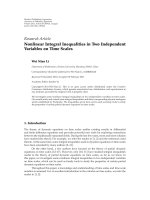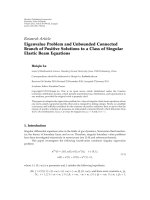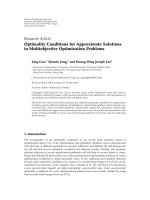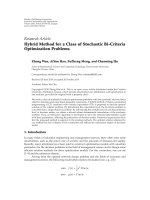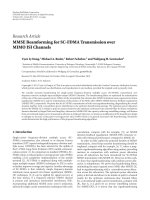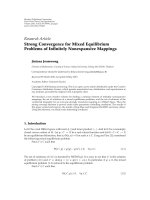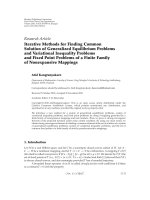Báo cáo hóa học: " Research Article Eigenvalue Problems for p-Laplacian Functional Dynamic Equations on Time Scales" pot
Bạn đang xem bản rút gọn của tài liệu. Xem và tải ngay bản đầy đủ của tài liệu tại đây (495.2 KB, 9 trang )
Hindawi Publishing Corporation
Advances in Difference Equations
Volume 2008, Article ID 879140, 9 pages
doi:10.1155/2008/879140
Research Article
Eigenvalue Problems for p-Laplacian Functional
Dynamic Equations on Time Scales
Changxiu Song
School of Applied Mathematics, Guangdong University of Technology, Guangzhou 510006, China
Correspondence should be addressed to Changxiu Song,
Received 29 February 2008; Accepted 25 June 2008
Recommended by Johnny Henderson
This paper is concerned with the existence and nonexistence of positive solutions of the p-Laplacian
functional dynamic equation on a time scale, φ
p
x
t
∇
λatfxt,xut 0, t ∈ 0,T,
x
0
tψt, t ∈ −τ, 0, x0 − B
0
x
0 0, x
T0. We show that there exists a λ
∗
> 0
such that the above boundary value problem has at least two, one, and no positive solutions for
0 <λ<λ
∗
,λ λ
∗
and λ>λ
∗
, respectively.
Copyright q 2008 Changxiu Song. This is an open access article distributed under the Creative
Commons Attribution License, which p ermits unrestricted use, distribution, and reproduction in
any medium, provided the original work is properly cited.
1. Introduction
Let
T be a closed nonempty subset of R,andletT have the subspace topology inherited from
the Euclidean topology on
R. In some of the current literature, T is called a time scale please
see 1, 2. For notation, we will use the convention that, for each interval J of
R,Jwill denote
time-scale interval, that is, J : J ∩
T.
In this paper, let
T be a time scale such that −τ, 0,T ∈ T. We are concerned with the
existence of positive solutions of the p-Laplacian dynamic equation on a time scale
φ
p
x
Δ
t
∇
λatf
xt,x
μt
0,t∈ 0,T,
x
0
tψt,t∈ −τ, 0,x0 − B
0
x
Δ
0
0,x
Δ
T0,
1.1
where φ
p
u is the p-Laplacian operator, that is, φ
p
u|u|
p−2
u, p > 1, φ
p
−1
uφ
q
u,
where 1/p 1/q 1.
H1 The function f :
R
2
→R
is continuous and nondecreasing about each element;
f0, 0 ≥ c>0.
2 Advances in Difference Equations
H2 The function a :
T→R
is left dense continuous i.e., a ∈ C
ld
T, R
and does not
vanish identically on any closed subinterval of 0,T.HereC
ld
T, R
denotes the set
of all left dense continuous functions from
T to R
.
H3 ψ : −τ,0→
R
is continuous and τ>0.
H4 μ : 0,T→−τ, T is continuous, μt ≤ t for all t.
H5 B
0
: R→R is continuous and nondecreasing; B
0
kskB
0
s,k∈ R
and satisfies that
there exist β ≥ δ>0 such that
δs ≤ B
0
s ≤ βs for s ∈ R
. 1.2
H6 lim
x→∞
fx, ψs/x
p−1
∞ uniformly in s ∈ −τ,0.
p-Laplacian problems with two-, three-, m-point boundary conditions for ordinary
differential equations and finite difference equations have been studied extensively, for
example, see 1–4 and references therein. However, there are not many concerning the p-
Laplacian problems on time scales, especially for p-Laplacian functional dynamic equations
on time scales.
The motivations for the present work stems from many recent investigations in 5–10
and references therein. Especially, Kaufmann and Raffoul 7 considered a nonlinear functional
dynamic equation on a time scale and obtained sufficient conditions for the existence of
positive solutions, Li and Liu 10 studied the eigenvalue problem for second-order nonlinear
dynamic equations on time scales. In this paper, our results show that the number of positive
solutions of 1.1 is determined by the parameter λ. That is to say, we prove that there exists a
λ
∗
> 0 such that 1.1 has at least two, one, and no positive solutions for 0 <λ<λ
∗
,λ λ
∗
and
λ>λ
∗
, respectively.
For convenience, we list the following well-known definitions which can be found in
11–13 and the references therein.
Definition 1.1. For t<sup
T and r>inf T, define the forward jump operator σ and the
backward jump operator ρ, respectively, as
σtinf{τ ∈
T | τ>t}∈T,ρrsup{τ ∈ T | τ<r}∈T ∀t, r ∈ T. 1.3
If σt >t,tis said to be right scattered, and if ρr <r,ris said to be left scattered. If σtt, t
is said to be right dense, and if ρrr, r is said to be left dense. If
T has a right-scattered
minimum m, define
T
κ
T −{m}; otherwise set T
κ
T. If T has a left-scattered maximum M,
define
T
κ
T −{M}; otherwise set T
κ
T.
Definition 1.2. For x :
T→R and t ∈ T
κ
, define the deltaderivative of xt,x
Δ
t, to be the
number when it exists, with the property that, for any ε>0, there is a neighborhood U of t
such that
x
σt
− xs
− x
Δ
t
σt − s
<ε
σt − s
∀s ∈ U. 1.4
For x :
T→R and t ∈ T
κ
, define the nabla derivative of xt,x
∇
t, to be the number when it
exists, with the property that, for any ε>0, there is a neighborhood V of t such that
x
ρt
− xs
− x
∇
t
ρt − s
<ε
ρt − s
∀s ∈ V. 1.5
If
T R,thenx
Δ
tx
∇
tx
t. If T Z,thenx
Δ
txt 1 − xt is forward
difference operator while x
∇
txt − xt − 1 is the backward difference operator.
Changxiu Song 3
Definition 1.3. If F
Δ
tft, then define the delta integral by
t
a
fsΔs Ft−Fa. If Φ
∇
t
ft, then define the nabla integral by
t
a
fs∇s Φt − Φa.
The following lemma is crucial to prove our main results.
Lemma 1.4 14. Let E be a Banach space and let P be a cone in E.Forr>0,defineP
r
{x ∈ P :
||x|| <r}. Assume that F :
P
r
→P is completely continuous such that Fx
/
x for x ∈ ∂P
r
{x ∈ P :
||x|| r}.
i If ||Fx|| ≥ ||x|| for x ∈ ∂P
r
, then iF, P
r
,P0.
ii If ||Fx|| ≤ ||x|| for x ∈ ∂P
r
, then iF, P
r
,P1.
2. Positive solutions
We note that xt is a solution of 1.1 if and only if
xt
⎧
⎪
⎪
⎪
⎪
⎪
⎪
⎪
⎪
⎨
⎪
⎪
⎪
⎪
⎪
⎪
⎪
⎪
⎩
B
0
φ
q
T
0
λarf
xr,x
μr
∇r
t
0
φ
q
T
s
λarf
xr,x
μr
∇r
Δs, t ∈ 0,T,
ψt,t∈ −τ,0.
2.1
Let E C
ld
0,T, R be endowed with the norm ||x|| max
t∈0,T
|xt| and define the
cone of E by
P
x ∈ E : xt ≥
δ
T β
x for t ∈ 0,T
. 2.2
Clearly, E is a Banach space with the norm x.Foreachx ∈ E,extendxt to −τ, T
with xtψt for t ∈ −τ,0.
Define F
λ
: P→E as
F
λ
xtB
0
φ
q
T
0
λarf
xr,x
μr
∇r
t
0
φ
q
T
s
λarf
xr,x
μr
∇r
Δs, t ∈ 0,T.
2.3
We seek a fixed point, x
1
,ofF
λ
in the cone P. Define
xt
⎧
⎨
⎩
x
1
t,t∈ 0,T,
ψt,t∈ −τ,0.
2.4
Then xt denotes a positive solution of BVP 1.1.
4 Advances in Difference Equations
It follows from 2.3 that the following lemma holds.
Lemma 2.1. Let F
λ
be defined by 2.3.Ifx ∈ P ,then
i F
λ
P ⊂ P.
ii F
λ
: P→P is completely continuous.
The proof of Lemma 2.1 can be found in 15.
We need to define further subsets of 0,T with respect to the delay μ. Set
Y
1
:
t ∈ 0,T : μt < 0
; Y
2
:
t ∈ 0,T : μt ≥ 0
. 2.5
Throughout this paper, we assume Y
1
/
∅ and φ
q
Y
1
ar∇r > 0.
Lemma 2.2. Suppose that (H1)–(H5) hold. Then there exists a λ
∗
> 0 such that the operator F
λ
has a
fixed point x
∗
∈ P \{θ} at λ
∗
,whereθ is the zero element of the Banach space E.
Proof. Set
etB
0
φ
q
T
0
ar∇r
t
0
φ
q
T
s
ar∇r
Δs, t ∈ 0,T. 2.6
We know that e ∈ P. Let λ
∗
M
−1
f
e
, where
M
f
e
max
r∈0,T
f
er,e
μr
≥ c>0,
F
λ
∗
x
tB
0
φ
q
T
0
λ
∗
arf
xr,x
μr
∇r
t
0
φ
q
T
s
λ
∗
arf
xr,x
μr
∇r
Δs, t ∈ 0,T.
2.7
From above, we have
et ≥
F
λ
∗
e
t. 2.8
Let x
0
tet and x
n
tF
λ
∗
x
n−1
t,n 1, 2, ,t∈ 0,T. Then
x
0
t ≥ x
1
t ≥···≥x
n
t ≥···≥
cλ
∗
q−1
et. 2.9
By the Lebesgue dominated convergence theorem 16 together with H3, it follows that
{x
n
}
∞
n0
{F
n
λ
∗
x
0
}
∞
n0
decreases to a fixed point x
∗
∈ P \{θ} of the operator F
λ
∗
. The proof is
complete.
Lemma 2.3. Suppose that (H1)–(H6) hold and that I ⊂ b, ∞ for some b>0. Then there exists a
constant C
I
> 0 such that for all λ ∈ I and all possible fixed points x of F
λ
at λ, one has ||x|| <C
I
.
Proof. Set
S {x ∈ P : F
λ
x x, λ ∈ I}. 2.10
Changxiu Song 5
We need to prove that there exists a constant C
I
> 0 such that x <C
I
for all x ∈ S. If the
number of elements of S is finite, then the result is obvious. If not, without loss of generality,
we assume that there exists a sequence {x
n
}
∞
n0
such that lim
n→∞
x
n
∞,wherex
n
∈ P is
the fixed point of the operator F
λ
defined by 2.3 at λ
n
∈ I n 1, 2, .
Then
x
n
t ≥
δ
T β
x
n
,t∈ 0,T. 2.11
We choose J>0 such that
Jb
q−1
δ
2
T β
φ
q
Y
1
ar∇r
> 1, 2.12
L>0 such that
f
x, ψs
≥ Jx
p−1
,x>L,s∈ −τ,0. 2.13
In view of H6 there exists an N sufficiently large such that x
N
>L.For t ∈ 0,T, we have
x
N
F
λ
N
x
N
F
λ
N
x
N
T
≥ δφ
q
T
0
λ
N
arf
x
N
r,x
N
μr
∇r
≥ δφ
q
Y
1
λ
N
arf
x
N
r,ψ
μr
∇r
>δJb
q−1
min
t∈Y
1
φ
q
Y
1
arx
p−1
N
r∇r
≥
Jb
q−1
δ
2
T β
x
N
φ
q
Y
1
ar∇r
>
x
N
,
2.14
which is a contradiction. The proof is complete.
Lemma 2.4. Suppose that (H1)–(H5) hold and that the operator F
λ
has a positive fixed point x in P at
λ>0. Then for every λ
∗
∈ 0,λ the operator F
λ
has a fixed point x
∗
∈ P \{θ} at λ
∗
,andx
∗
<x.
Proof. Let xt be the fixed point of the operator F
λ
at λ.Then
xtB
0
φ
q
T
0
λarf
xr,x
μr
∇r
t
0
φ
q
T
s
λarf
xr,x
μr
∇r
Δs
>B
0
φ
q
T
0
λ
∗
arf
xr,x
μr
∇r
t
0
φ
q
T
s
λ
∗
arf
xr,x
μr
∇r
Δs,
2.15
6 Advances in Difference Equations
where 0 <λ
∗
<λ.Set
F
λ
∗
x
tB
0
φ
q
T
0
λ
∗
arf
xr,x
μr
∇r
t
0
φ
q
T
s
λ
∗
arf
xr,x
μr
∇r
Δs,
2.16
x
0
txt, and x
n
F
λ
∗
x
n−1
F
n
λ
∗
x
0
t. Then
cλ
∗
q−1
et ≤ x
n1
≤ x
n
≤···≤ x
1
t ≤ x
0
t, 2.17
where et is also defined by 2.6, which implies that {F
n
λ
∗
x}
∞
n0
decreases to a fixed point
x
∗
∈ P \{θ} of the operator F
λ
∗
,andx
∗
<x.The proof is complete.
Lemma 2.5. Suppose that (H1)–(H6) hold. Let ∧ {λ>0:F
λ
have at least one fixed point at λ in P}.
Then ∧ is bounded above.
Proof. Suppose to the contrary that there exists a fixed point sequence {x
n
}
∞
n0
⊂ P of F
λ
at λ
n
such that lim
n→∞
λ
n
∞. Then we need to consider two cases:
i there exists a constant H>0 such that x
n
≤H, n 0, 1, 2 ;
ii there exists a subsequence {x
n
k
}
∞
k1
such that lim
k→∞
||x
n
k
|| ∞ which is impossible
by Lemma 2.3.
Only i is considered. We can choose M>0 such that f0, 0 >MH, and further
fx
n
,x
n
μ >MH.Fort ∈ 0,T,wehave
x
n
tB
0
φ
q
T
0
λ
n
arf
x
n
r,x
n
μr
∇r
t
0
φ
q
T
s
λ
n
arf
x
n
r,x
n
μr
∇r
Δs.
2.18
Now we consider 2.18.Assume that the case i holds. Then
H ≥ x
n
t ≥ B
0
φ
q
T
0
λ
n
arMH∇r
t
0
φ
q
T
s
λ
n
arMH∇r
Δs
λ
n
MH
q−1
et
≥
λ
n
MH
q−1
δ
T β
e
2.19
leads to
1 ≥
λ
n
M
q−1
H
q−2
δ
T β
e for t ∈ 0,T, 2.20
which is a contradiction. The proof is complete.
Lemma 2.6. Let λ
∗
sup ∧. Then ∧ 0,λ
∗
, where ∧ is defined just as in Lemma 2.5.
Changxiu Song 7
Proof. In view of Lemma 2.4, it follows that 0,λ
∗
⊂∧. We only need to prove λ
∗
∈∧. In
fact, by the definition of λ
∗
, we may choose a distinct nondecreasing sequence {λ
n
}
∞
n1
⊂∧
such that lim
n→∞
λ
n
λ
∗
. Let x
n
∈ P be the positive fixed point of F
λ
at λ
n
,n 1, 2,
By Lemma 2.3, {x
n
}
∞
n1
is uniformly bounded, so it has a subsequence denoted by {x
n
}
∞
n1
,
converging to x
λ
∗
∈ P. Note that
x
n
tB
0
φ
q
T
0
λ
n
arf
x
n
r,x
n
μr
∇r
t
0
φ
q
T
s
λ
n
arf
x
n
r,x
n
μr
∇r
Δs.
2.21
Taking the limitation n→∞ to both sides of 2.21, and using the Lebesgue dominated
convergence theorem 16,wehave
x
λ
∗
B
0
φ
q
T
0
λ
∗
arf
x
λ
∗
r,x
λ
∗
μr
∇r
t
0
φ
q
T
s
λ
∗
arf
x
λ
∗
r,x
λ
∗
μr
∇r
Δs,
2.22
which shows that F
λ
has a positive fixed point x
λ
∗
at λ λ
∗
. The proof is complete.
Theorem 2.7. Suppose that (H1)–(H6) hold. Then there exists a λ
∗
> 0 such that 1.1 has at least two,
one, and no positive solutions for 0 <λ<λ
∗
,λ λ
∗
and λ>λ
∗
, respectively.
Proof. Assume that H1–H5 hold. Then there exists a λ
∗
> 0 such that F
λ
has a fixed point
x
λ
∗
∈ P \{θ} at λ λ
∗
. In view of Lemma 2.4, F
λ
also has a fixed point x
λ
<x
λ
∗
,x
λ
∈ P \{θ}
and 0 <λ
<λ
∗
. Note that f is continuous on R
2
.For0<λ<λ
∗
, there exists a δ
0
> 0 such
that
f
x
λ
∗
r δ, x
λ
∗
μr
δ
− f
x
λ
∗
r,x
λ
∗
μr
≤ f0, 0
λ
∗
λ
− 1
for r ∈ 0,T, 0 <δ≤ δ
0
.
2.23
Hence,
λ
arf
x
λ
∗
rδ, x
λ
∗
μr
δ
− λ
∗
arf
x
λ
∗
r,x
λ
∗
μr
λ
ar
f
x
λ
∗
rδ, x
λ
∗
μr
δ
− f
x
λ
∗
r,x
λ
∗
μr
−
λ
∗
− λ
arf
x
λ
∗
r,x
λ
∗
μr
≤
λ
∗
− λ
arf0, 0 −
λ
∗
− λ
f
x
λ
∗
r,x
λ
∗
μr
λ
∗
− λ
ar
f0, 0 − f
x
λ
∗
r,x
λ
∗
μr
≤ 0, ∀r ∈ 0,T.
2.24
From above, we have
F
λ
x
λ
∗
δ
≤ F
λ
∗
x
λ
∗
x
λ
∗
<x
λ
∗
δ. 2.25
8 Advances in Difference Equations
Set R
1
||x
λ
∗
tδ|| for t ∈ 0,T and P
R
1
{x ∈ P : ||x|| <R
1
}.WehaveF
λ
x
/
x for x ∈ ∂R
1
.
By Lemma 2.1, iF
λ
,P
R
1
,P1. In view of H6, we can choose L>R
1
> 0 such that
f
x, ψs
≥ Jx
p−1
,
Jλ
q−1
δ
2
T β
φ
q
Y
1
ar∇r
> 1forx > L, s ∈ −τ,0.
2.26
Set
R
2
T β
δ
L 1,P
R
2
x ∈ P : x <R
2
. 2.27
Similar to Lemma 2.3, it is easy to obtain that
F
λ
x
F
λ
x
T
≥ δφ
q
T
0
λarf
xr,x
μr
∇r
≥ δφ
q
Y
1
λarf
xr,ψ
μr
∇r
>δJλ
q−1
min
t∈Y
1
xt
φ
q
Y
1
ar∇r
≥
Jλ
q−1
δ
2
T β
xφ
q
Y
1
ar∇r
> x for x ∈ ∂P
R
2
.
2.28
In view of Lemma 2.1, iF
λ
,P
R
2
,P0. By the additivity of fixed point index,
i
F
λ
,P
R
2
\ P
R
1
,P
i
F
λ
,P
R
2
,P
− i
F
λ
,P
R
1
,P
−1. 2.29
So, F
λ
has at least two fixed points in P. The proof is complete.
Acknowledgments
This work was supported by Grant 10571064 from NNSF of China, and by a grant from NSF of
Guangdong.
References
1 R. Avery and J. Henderson, “Existence of three positive pseudo-symmetric solutions for a one-
dimensional p-Laplacian,” Journal of Mathematical Analysis and Applications, vol. 277, no. 2, pp. 395–404,
2003.
2 Y. Liu and W. Ge, “Twin positive solutions of boundary value problems for finite difference equations
with p-Laplacian operator,” Journal of Mathematical Analysis and Applications, vol. 278, no. 2, pp. 551–
561, 2003.
Changxiu Song 9
3 A. Cabada, “Extremal solutions for the difference φ-Laplacian problem with nonlinear functional
boundary conditions,” Computers & Mathematics with Applications, vol. 42, no. 3–5, pp. 593–601, 2001.
4 F H. Wong, “Existence of positive solutions for m-Laplacian boundary value problems,” Applied
Mathematics Letters, vol. 12, no. 3, pp. 11–17, 1999.
5 C. Song, “Positive solutions of functional difference equations with p-Laplacian operator,” Advances
in Difference Equations, vol. 2006, Article ID 82784, 9 pages, 2006.
6 H R. Sun and W T. Li, “Positive solutions for nonlinear three-point boundary value problems on time
scales,” Journal of Mathematical Analysis and Applications, vol. 299, no. 2, pp. 508–524, 2004.
7 E. R. Kaufmann and Y. N. Raffoul, “Positive solutions for a nonlinear functional dynamic equation on
a time scale,” Nonlinear Analysis: Theory, Methods & Applications, vol. 62, no. 7, pp. 1267–1276, 2005.
8 H. Luo and Q. Ma, “Positive solutions to a generalized second-order three-point boundary-value
problem on time scales,” Electronic Journal of Differential Equations, vol. 2005, no. 17, pp. 1–14, 2005.
9 Z. He, “Double positive solutions of three-point boundary value problems for p-Laplacian dynamic
equations on time scales,” Journal of Computational and Applied Mathematics, vol. 182, no. 2, pp. 304–315,
2005.
10 W T. Li and X L. Liu, “Eigenvalue problems for second-order nonlinear dynamic equations on time
scales,” Journal of Mathematical Analysis and Applications, vol. 318, no. 2, pp. 578–592, 2006.
11 M. Bohner and A. Peterson, Dynamic Equations on Time Scales. An Introduction with Application,
Birkh
¨
auser, Boston, Mass, USA, 2001.
12 R. P. Agarwal and M. Bohner, “Basic calculus on time scales and some of its applications,” Results in
Mathematics, vol. 35, no. 1-2, pp. 3–22, 1999.
13 S. Hilger, “Analysis on measure chains—a unified approach to continuous and discrete calculus,”
Results in Mathematics, vol. 18, no. 1-2, pp. 18–56, 1990.
14 D. Guo and V. Lakshmikantham,
Nonlinear Problems in Abstract Cones, vol. 5 of Notes and Reports in
Mathematics in Science and Engineering, Academic Press, Boston, Mass, USA, 1988.
15 C. Song, “Existence of solutions for p-Laplacian functional dynamic equations on time scales,”
Electronic Journal of Differential Equations, vol. 2006, no. 113, pp. 1–8, 2006.
16 B. Aulbach and L. Neidhart, “Integration on measure chains,” in Proceedings of the 6th International
Conference on Difference Equations, pp. 239–252, CRC, Augsburg, Germany, July-August 2004.

